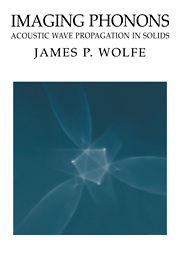Book contents
- Frontmatter
- Contents
- Preface
- Prologue – Anisotropic heat flow in crystals
- 1 Ballistic heat pulses and phonon imaging – A first look
- 2 Phonon focusing
- 3 Generation and detection of phonons – Experimental aspects
- 4 Focusing in cubic crystals
- 5 Acoustic symmetry and piezoelectricity
- 6 Lattice dynamics
- 7 Imaging of dispersive phonons
- 8 Phonon dynamics
- 9 Bulk scattering of phonons – Experiments
- 10 Quasidiffusion and the phonon source
- 11 Phonon scattering at interfaces
- 12 Refraction and reflection at solid/solid interfaces – Experiment
- 13 Imaging ultrasound in solids
- 14 Imaging surface acoustic waves
- 15 Interactions of ballistic phonons with electrons
- Appendix I Algebraic solution to the wave equation
- Appendix II Abbreviated tensor notation and group velocity
- Appendix III Survey of phonon focusing in cubic crystals
- Index
3 - Generation and detection of phonons – Experimental aspects
Published online by Cambridge University Press: 24 March 2010
- Frontmatter
- Contents
- Preface
- Prologue – Anisotropic heat flow in crystals
- 1 Ballistic heat pulses and phonon imaging – A first look
- 2 Phonon focusing
- 3 Generation and detection of phonons – Experimental aspects
- 4 Focusing in cubic crystals
- 5 Acoustic symmetry and piezoelectricity
- 6 Lattice dynamics
- 7 Imaging of dispersive phonons
- 8 Phonon dynamics
- 9 Bulk scattering of phonons – Experiments
- 10 Quasidiffusion and the phonon source
- 11 Phonon scattering at interfaces
- 12 Refraction and reflection at solid/solid interfaces – Experiment
- 13 Imaging ultrasound in solids
- 14 Imaging surface acoustic waves
- 15 Interactions of ballistic phonons with electrons
- Appendix I Algebraic solution to the wave equation
- Appendix II Abbreviated tensor notation and group velocity
- Appendix III Survey of phonon focusing in cubic crystals
- Index
Summary
The physics of nonequilibrium phonons in crystals, as with most scientific phenomena, has been unveiled by a combination of experimental and theoretical work. We have seen that the propagation of acoustic phonons in elastically anisotropic media contains a rich spatial complexity. The advent of imaging techniques has permitted visual insights into elasticity theory and, as shown in later chapters, into the propagation and scattering of high-frequency phonons.
To study phonons one must be able to create and detect them. How does one jiggle the atoms in the crystal and detect their collective motion? Because the nuclei (or atomic cores) are charged, one possibility is the application of oscillating electric fields such as electromagnetic waves. Examples of this include ultrasound generation in piezoelectric materials and phonon generation by absorption of infrared light. Alternatively, because electronic motion produces time-varying local fields, an effective way of creating nonequilibrium phonons is to electrically or optically excite the electrons in the crystal. It comes as no surprise, then, that an efficient means of creating and detecting nonequilibrium phonons is to employ materials with high electron density – namely, metals. Conversely, the macroscopic motion of phonons is studied in materials with low densities of free carriers – namely, insulators and semiconductors. The common approach, therefore, is to attach metallic generators and detectors to the nonmetallic crystals of interest.
This chapter begins with an overview of the measurement techniques involved in a phonon-imaging experiment.
- Type
- Chapter
- Information
- Imaging PhononsAcoustic Wave Propagation in Solids, pp. 60 - 90Publisher: Cambridge University PressPrint publication year: 1998

